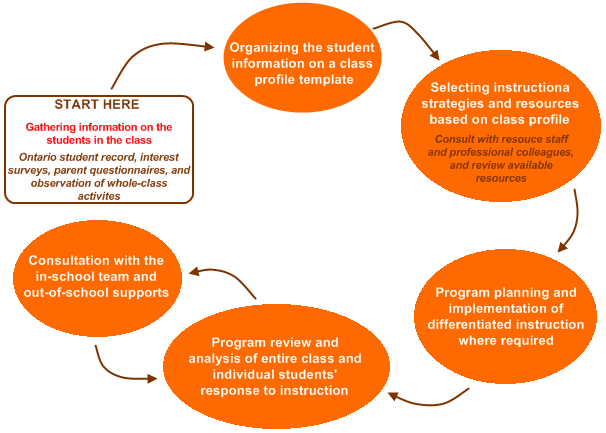Learning StylesClass ProfilesWhether it is a start to a new school year in September or a fresh new semester, almost every one of these classes will begin with a diverse set of new learners each possessing their own unique learning styles, strengths, needs, and challenges. To determine what stage each learner in the classroom has reached, a class profile, first and foremost, will collectively identity these areas in a students academic career (Education for All, 2005). Gathering information on the students in the class can be accomplished in several ways as an ultimate means of assessing a students academic background. For instance, teachers can have their students fill out interest surveys, have their parents fill out questionnaires, and/or simply observe the levels of interaction amongst the students during a whole-class activity at the beginning of the school year. Regardless of how the information is collected, an effective student profile questionnaire should successfully identify the students' interests and talents, their current place in the learning process, and their thoughts on learning (Education for All, 2005). This valuable information will help teachers modify the curriculum accordingly and make appropriate accommodations to their educational plan where needed.
Figure 1. Class Profile Flowchart, modified from (Education for All, 2005). There are six critical steps to follow when developing a class profile (Education for All, 2005) (Figure 1). Using the information provided from parent and student questionnaires, teachers can start to make diagnostic assessments of student achievement. Recall that for high school classes, interest surveys should include questions pertaining more to the course being taught than on a general level. Next, the teacher would have to summarize the information by organizing it into categories. Categories can be divided according to each student's strengths and "areas of need related to literacy, numeracy, and social-behavioural issues" (Education for All, 2005, p. 32). The third step involves selecting for instructional strategies and resources based on the strength, needs, and interests of the students. For instance, if a grade nine math teacher discovers that the majority of his/her students characterize themselves as being visual-spatial learners, a teacher would have to review available resources like Unifix cubes (Figure 2) for geometry class. Moreover, after the teacher has considered the curriculum, instructional strategies, and the patterns in the classroom using the individual student profiles, the teacher can plan their lessons where differentiated instructions are required. The fifth step is to monitor and review the students progress to see whether it has helped improve the students academic performance, and finally, seek further assistance by consulting with colleagues the effectiveness of the implemented teaching strategies (Education for All, 2005).
Figure 2. Unifix blocks and other such math cube sets are commonly used to help students learn number and math concepts - ideal for visual learners. Class profiles are essential for educators to implement in their classrooms for several reasons. By having students fill out a questionnaire in terms of their interests, strengths, challenges, and past academic grades, it reveals an important part of the student's academic history that may not have been recorded in their student record. A student who has done poorly for the past five years of their life, for instance, may be due to a more serious issue, which past educators failed to recognize in the student. Therefore, a class profile may help an educator be the first person to suspect that a student has special needs that have not been addressed before. Knowing each student at a greater level from the start of the school year may also encourage an educator to develop more comprehensive lesson plan that targets areas that can be stimulated or improved based on their suggested interests. For instance, if a grade nine teacher's class profile depicts that most student in their classroom dislike the concept of astronomy, one way to accommodate for this would be to make the unit short, but at the same time, concentrate on making the lesson plans very interesting by including material that will overly exceed their expectations. Organizing the information gathered from the students can also help teachers choose the right partners for each student or make an appropriate seating plan that will help students perform to their fullest learning potential. For instance, if a question on the questionnaire asks for the student's birth order in their family, the teacher would most likely want to pair up a first-born with a last-born, since a group of two last born students could result in less work being completed as a result of their joyful characteristic attitudes (see Birth Order). This way, the teacher can "help the students ... work together and cooperate with one another" (Education for All, 2005, p.32).
|



